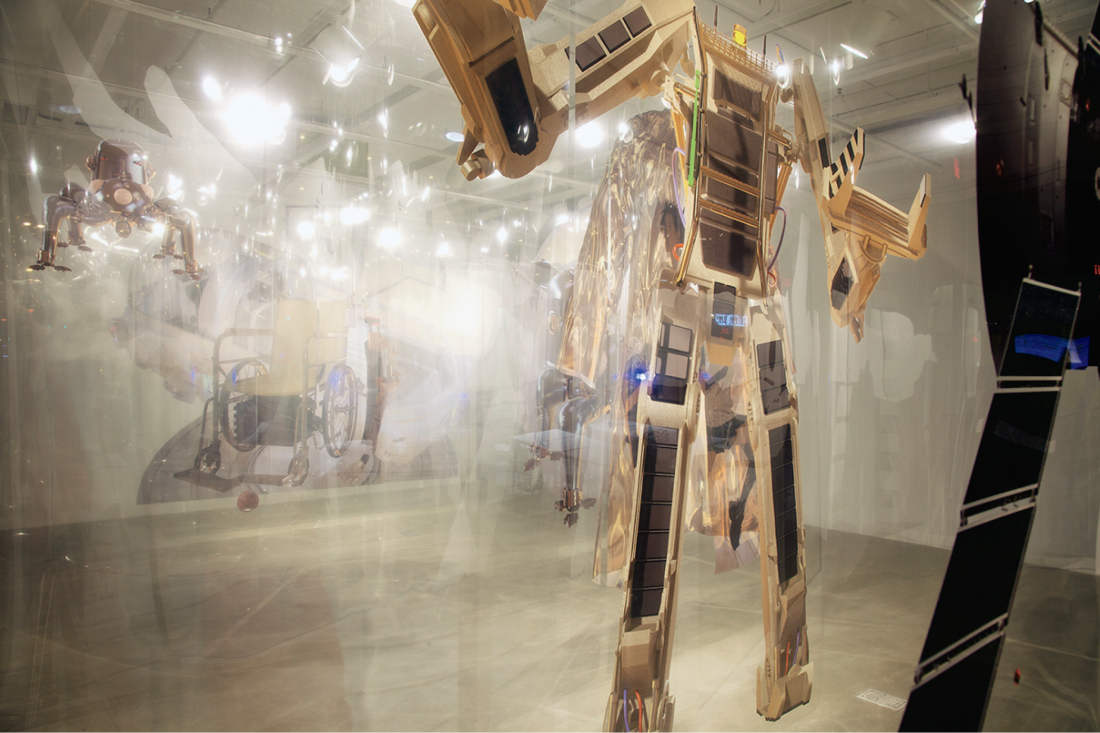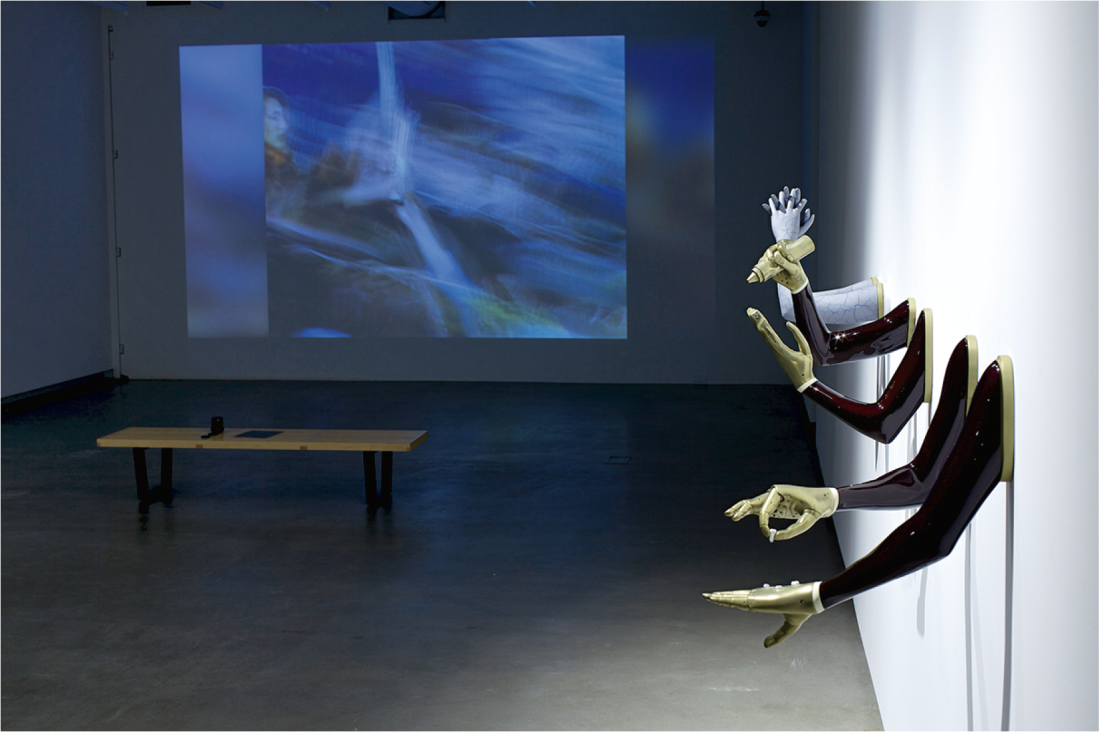Aleksandra Domanović
“Though both are bound in the spiral dance, I would rather be a cyborg than a goddess.” With this reflection, theorist Donna Haraway concluded her groundbreaking essay, “A Cyborg Manifesto,” drawing a sharp conceptual distinction between what has often been termed second and third-wave feminism. In part, Haraway sought to emancipate feminism from the conceptualization of women as inherently natural, essential and spiritual beings, and conversely, to assert a post-humanist notion of women as technological, fragmented and augmentable protean subjects.
Aleksandra Domanović’s recent show “Mother of This Domain” at Plug In ICA, curated by Vancouver-based Caitlin Jones, reveals work fully commensurate with digital geographies, prosthetic extensions and technological interfaces, yet posits a remarkably stable, knowable and biologically uncomplicated notion of women from someone so clearly engaged and influenced by contemporary cyberfeminism. Born in the former Socialist Federal Republic of Yugoslavia in 1980, the Berlin-based artist’s practice continues to reflect on the passing of her former homeland, as well as its virtual echo within the digital confines of the World Wide Web.
Presented with minimal explanation—frustratingly so—the exhibition’s diverse works demonstrate Domanović’s impressive command of mixed media, as well as her mastery of emergent technologies which integrate computer-based practice and the material production of objects. Split between two rooms, the show consists of four works in Gallery 1 and a large installation piece in Gallery 2. Though tied with small gestural references and themes, the installation in the second gallery, Things to Come, is arguably the most accessible part of the exhibition. Consisting of a series of seven large polyester foil panels hung horizontally across the room, the work fills the entire space of the gallery. Each panel contains large luminous images of technology, or at least futuristic objects, which interface and integrate physical bodies and machines. The images are all sourced from popular science fiction films centred around female protagonists. Bright, looming and dynamic, Things to Come playfully and poignantly illustrates the ways that familiar and speculative objects can be sites for fantastical appropriation and possibility. Though the images are artifacts of corporate mass culture, Domanović highlights their inspirational and transformative power as a resource for the expansion of female imagination and horizons of possibility. The digital representations are themselves produced through a process of 3D modelling and image capture, where the image is transferred using a flatbed printer that utilizes UV light to adhere the acrylic inks directly to the plastic. Each panel forms a permeable wall that is then divided into five sections to allow spectators to walk and progress through the installation.

Installation view, “Mother of This Domain,” 2015, Plug In Institute of Contemporary Art, Winnipeg. Photograph William Eakin. Courtesy Plug In Institute of Contemporary Art.
Continuing at least in part with the themes of women’s agency and technology, the works in the main gallery address more directly the SFR of Yugoslavia and its disintegration, themes culled, one surmises, from more intimate sets of associations and histories. Remarkably different in form, materials and presentation than Things to Come, these pieces are nonetheless linked by representational clues, such as the presence of red apples and the recurrent presence of the Belgrade hand—an early prosthetic hand, developed in 1963 in the SFR of Yuogslavia.
Arms and hands are rich source of creative material for Domanović. Indeed, her piece Substance of Human Origins is a triptych sculpture consisting of three sets of arms extending out from the gallery wall. Made from polyurethane, the hands (or hand tools) have metallic flocking, giving them a rich silver and gold finish.
One of the most surprising works of the exhibition is Untitled (30.III.2010)—a piece which in part is intended as a memorial to the now extinct YU internet domain. Consisting of three sculptural columns, standing about three feet in height, the work is composed of stacks of approximately 7500 pages of A4 paper (the standard printer and photocopier size in Europe). Wrapping around the flat sides and the tight right angles of the stacks, are open-sourced and digitally processed photographs of a riot taken at a football match, which had been archived on a Flickr account on the YU domain. The images themselves are rainbow-hued bleeds that at first appear as stylized landscapes, but on closer inspection reveal actual crowds of people, fire and smoke.
Whatever ambivalence might exist regarding these hauntingly lovely images, it should take nothing away from Domanović’s creative and innovative technological savvy. The set of three sculptures utilizes the nearly obsolete technology of ink-jet printing to generate the images along the vertical sides of the stacks. Rather than producing a traditional two-dimensional image, Domanović reimagines and realigns the perspective, conceptualizing the three-dimensional possibilities of paper through layers of ink piled page after page, creating an assembled work that is realized at the outer edges of the paper.

Installation view, “Mother of This Domain,” 2015, Plug In Institute of Contemporary Art, Winnipeg. Photograph William Eakin. Courtesy Plug In Institute of Contemporary Art.
In contrast to these sculptural pieces, the final two works are forms of alternative historical narratives. The first is a deceptively simple, self consciously random and somewhat irreverent timeline titled The Future Was at Her Finger Tips and the second is a 35-minute video From YU to ME, 2013–2014, projected on the back wall. The timeline highlights a number of historical events and figures, such as the British mathematician Ada Lovelace, who wrote what could be understood as the first computer programing code; Rajko Tomović’s development of the Belgrade Arm; and the supposed declaration of New Zealand as smoke free in 2025.
The video, which is in many ways a conventional documentary, provides a narrative history of the development of the Internet in the SFR of Yugoslavia, the establishment of the YU domain, and ultimately the fate of the YU suffix, which lingered on until 2010, years after the break-up of the country. Much of the video focuses on two women, Borka Jerman Blažič and Mirjana Tasic, who had been central to the history of computing and the Internet. Blažič, an academic and computer scientist based in Ljubljana, Slovenia, takes credit for establishing the internet in the country, making Yugoslavia open to the World Wide Web and for instigating the YU suffix—she is arguably the titular mother of the domain. Both women, dressed in apple red, demonstrate a productive energy and creative dynamism that buttresses their assertion of centrality to the establishment of national computer networking and digital communications.
The documentary contains only fleeting references to the wars of disintegration in the former Yugoslavia. At one point Blažič mentions travelling to Belgrade to speak to ranking members of the Yugoslavian Intelligence Service over their concern that the YU domain was administered in Ljubljana, Slovenia rather than the Yugoslavian (later Serbian) capital of Belgrade. One of the officials Blažič meets is supposedly the brother of paramilitary leader, football club president and gangster, Željko (Arkan) Ražnatović, who was indicted for perpetrating crimes against humanity by the International Criminal Tribunal for the former Yugoslavia (ICTY) and is widely believed to have been linked to atrocities such as the Vukovar Hospital (1991) and the Srebrenica genocide (1995). These bits of history are present in this work only in the most fragmented and tangential ways, that is to say they are acknowledged but never the focus or the framework for Domanović. This is an understandable, though not entirely unproblematic, approach, in that a concentration on the ethnic/nationalist wars could easily over-determine the work, flattening out and effacing Domanović’s subtle reflections of both technology and women. Nonetheless, I worry about the practice of brushing up against atrocities in any artistic production, without some deeper contextual engagement. The association of aesthetics with traumatic historic events inevitably provides an individual work with a seriousness and significance that might otherwise be indiscernible in the visual language of the piece. Such connections, even autobiographical references taken from personal experience and circumstance, ultimately need some sort of ethical explication, notwithstanding an artist’s refusal to provide a coherent moral economy and narrative. ❚
“Mother of This Domain” was exhibited at Plug In ICA, Winnipeg, from September 26, 2015 to January 3, 2016.
David S Churchill is a queer cultural critic, sometime curator and professor of US history at the University of Manitoba.

